Analytical Formulation of the Electric Field Induced by Electrode Arrays: Towards Automated Dielectrophoretic Cell Sorting
Abstract
:1. Introduction
2. Electric Field Produced by an Electrode Array
2.1. Cell Sorting Using Parallel Electrode Arrays
2.2. Generic Solution of the Electric Potential Produced by an Electrode Array Expressed as a Fourier Series
- the spatial variables can be separated:
- the dependence along the axis can be expressed as a Fourier series:
3. Analytical Formulation of the Electric Potential Produced by One Plane of Electrode Array
3.1. Boundary Conditions of the Electric Potential
- the electric potential on the nth electrode is , ,
- the electric potential between two electrodes is linear, ,
- the electric potential is symmetrical across lateral boundaries, , , …, ,
- the potential is grounded at height h,
3.2. Analytical Formulation of the Fourier Coefficients Satisfying the Boundary Conditions
4. Generalization to the Analytical Formulation of the Electric Potential and the Dielectrophoretic Force Produced by Two Planes of Electrode Arrays
4.1. Generalization of the Electric Potential to the Case of Two Parallel Planar Arrays of Electrodes
4.2. Dielectrophoretic Force Formulation
5. Results and Discussion
5.1. Comparison between the Analytical Model and a Numerical Simulation
5.2. Influence of the Length of the Fourier Series
5.3. Computing Time of the Fourier Series
5.4. Discussion
6. Conclusions
Acknowledgments
Author Contributions
Conflicts of Interest
Abbreviations
| DEP | dielectrophoresis |
| FEM | finite element method |
References
- Lee, G.-H.; Kim, S.-H.; Ahn, K.; Lee, S.-H.; Park, J.Y. Separation and sorting of cells in microsystems using physical principles. J. Micromechan. Microeng. 2016, 26, 013003. [Google Scholar] [CrossRef]
- Karle, M.; Vashist, S.K.; Zengerle, R.; von Stetten, F. Microfluidic solutions enabling continuous processing and monitoring of biological samples: A review. Anal. Chim. Acta 2016, 929, 1–22. [Google Scholar] [CrossRef] [PubMed]
- Zhou, T.; Yeh, L.-H.; Li, F.-C.; Mauroy, B.; Joo, S.W. Deformability-based electrokinetic particle separation. Micromachines 2016, 7, 170. [Google Scholar] [CrossRef]
- Morgan, H.; Green, N. Dielectrophoresis. In Encyclopedia of Microfluidics and Nanofluidics; Li, D., Ed.; Springer: New York, NY, USA, 2014; pp. 350–357. [Google Scholar]
- Hughes, M.P. Fifty years of dielectrophoretic cell separation technology. Biomicrofluidics 2016, 10, 032801. [Google Scholar] [CrossRef] [PubMed]
- Natu, R.; Martinez-Duarte, R. Numerical model of streaming DEP for stem cell sorting. Micromachines 2016, 7, 217. [Google Scholar] [CrossRef]
- Braff, W.A.; Pignier, A.; Buie, C.R. High sensitivity three dimensional insulator-based dielectrophoresis. Lab Chip 2012, 7, 1327–1331. [Google Scholar] [CrossRef] [PubMed]
- Van den Driesche, S.; Rao, V.; Puchberger-Enengl, D.; Witarski, W.; Vellekoop, M.J. Continuous cell from cell separation by traveling wave dielectrophoresis. Sens. Actuators B Chem. 2012, 170, 207–214. [Google Scholar] [CrossRef]
- Gascoyne, P.R.C.; Sangjo, S.; Noshari, J.; Becker, F.F. Correlations between the dielectric properties and exterior morphology of cells revealed by dielectrophoretic field-flow fractionation. Electrophoresis 2013, 34, 1042–1050. [Google Scholar] [CrossRef] [PubMed]
- Braschler, T.; Demierre, N.; Nascimento, E.; Silva, T.; Oliva, A.G.; Renaud, P. Continuous separation of cells by balanced dielectrophoretic forces at multiple frequencies. Lab Chip 2008, 8, 280–286. [Google Scholar] [CrossRef] [PubMed]
- Shim, S.; Stemke-Hale, K.; Noshari, J.; Becker, F.F.; Gascoyne, P.R. Dielectrophoresis has broad applicability to marker-free isolation of tumor cells from blood by microfluidic systems. Biomicrofluidics 2013, 7, 011808. [Google Scholar] [CrossRef] [PubMed]
- Lenshof, A.; Laurell, T. Countinuous separation of cells and particules in microfluidic system. Chem. Soc. Rev. 2010, 37, 1203–1217. [Google Scholar] [CrossRef] [PubMed]
- Tian, L.; Gao, M.; Gui, L. A microfluidic chip for liquid metal droplet generation and sorting. Micromachines 2017, 8, 39. [Google Scholar] [CrossRef]
- Holmes, D.; Sandison, M.E.; Green, N.G.; Morgan, H. On-chip high-speed sorting of micron-sized particles for high-throughput analysis. IEEE Proc. Nanobiotechnol. 2005, 152, 129–135. [Google Scholar] [CrossRef] [PubMed]
- Ahn, K.; Kerbage, C.; Hunt, T.P.; Westervelt, R.M.; Link, D.R.; Weitz, D.A. Dielectrophoretic manipulation of drops for high-speed microfluidic sorting devices. Appl. Phys. Lett. 2006, 88, 024104. [Google Scholar] [CrossRef]
- Kharboutly, M.; Gauthier, M.; Chaillet, N. Modeling the trajectory of a microparticle in a dielectrophoresis device. J. Appl. Phys. 2009, 106, 1–7. [Google Scholar] [CrossRef]
- Luo, H.; Sun, W.; Yeow, J.T.W. Modelling and adaptive dynamic sliding mode control of dielectrophoresis-based micromanipulation. Trans. Inst. Meas. Control 2016. [Google Scholar] [CrossRef]
- Edwards, B.; Engheta, N.; Evoy, S. Electric tweezers: Experimental study of positive dielectrophoresis-based positioning and orientation of a nanorod. J. Appl. Phys. 2007, 102. [Google Scholar] [CrossRef]
- Zemánek, J.; Michálek, T.; Hurák, Z. Feedback control for noise-aided parallel micromanipulation of several particles using dielectrophoresis. Electrophoresis 2015, 36, 1451–1458. [Google Scholar] [CrossRef] [PubMed]
- Wang, X.; Wang, X.-B.; Becker, F.F.; Gascoyne, P.R.C. A theoretical method of electrical field analysis for dielectrophoretic electrode arrays using Green’s theorem. J. Phys. D Appl. Phys. 1996, 29, 1649–1660. [Google Scholar] [CrossRef]
- Morgan, H.; Izquierdo, A.G.; Bakewell, D.; Green, N.G.; Ramos, A. The dielectrophoretic and travelling wave forces generated by interdigitated electrode arrays: Analytical solution using Fourier series. J. Phys. D Appl. Phys. 2001, 34, 1554. [Google Scholar] [CrossRef]
- Chang, D.E.; Loire, S.; Mezié, I. Closed-form solution in the electrical field analysis for dielectrophoretic and travelling wave inter-digitated electrode arrays. J.Phys. D Appl. Phys. 2003, 36, 3073–3078. [Google Scholar] [CrossRef]
- Sun, T.; Grenn, N.G.; Morgan, H. Analytical solutions for the electric field and dielectrophoretic force in a dielectrophoretic focusing electrode structure. Appl. Phys. lett. 2008, 92, 173901. [Google Scholar] [CrossRef]
- Nerguizian, V.; Alazzam, A.; Roman, D.; Stiharu, I.; Burnier, M., Jr. Analytical solutions and validation of electric field and dielectrophoretic force in a bio-microfluidic channel. Electrophoresis 2012, 33, 426–435. [Google Scholar] [CrossRef] [PubMed]
- Gurtner, M.; Hengster-Movric, K.; Hurák, Z. Green’s function-based control-oriented modeling of electric field for dielectrophoresis. arXiv, 2017; arXiv:1703.01980. [Google Scholar] [CrossRef]
- Song, H.; Bennett, D.J. A semi-analytical approach using artificial neural network for dielectrophoresis generated by parallel electrodes. J. Electrost. 2010, 68, 49–56. [Google Scholar] [CrossRef]
- Kua, C.H.; Lam, Y.C.; Rodriguez, I.; Yang, C.; Youcef-Toumi, K. Cell Motion Model for Moving Dielectrophoresis. Anal. Chem. 2008, 80, 5454–5461. [Google Scholar] [CrossRef] [PubMed]
- Pohl, H.A.; Crane, J.S. Dielectrophoretic force. J. Theor. Biol. 1972, 37, 1–13. [Google Scholar] [CrossRef]
- Green, N.G.; Ramos, A.; Morgan, H. Numerical solution of the dielectrophoretic and travelling wave forces for interdigitated electrodes arrays using the finite element method. J. Electrost. 2002, 56, 235–254. [Google Scholar] [CrossRef]
- Jeans, J. The Mathematical Theory of Electricity and Magnetism; Cambridge University Press: London, UK, 1911; p. 200, Chapter VIII, Section 224. [Google Scholar]
- Lo, Y.J.; Lei, U. Quasistatic force and torque on a spherical particule under generalized dielectrophoresis in the vicinity of walls. Appl. Phys. Lett. 2009, 95, 253701. [Google Scholar] [CrossRef]
- Manaresi, N.; Romani, A.; Medoro, G.; Altomare, L.; Leonardi, A.; Tartagni, M.; Guerrier, R. A CMOS chip for individual cell manipulation and detection. IEEE J. Solid State Circuits 2003, 38, 2297–2305. [Google Scholar] [CrossRef]
- Gurtner, M.; Zemanek, J. Twin-beam real-time position estimation of micro-objects in 3D. Meas. Sci. Technol. 2016, 27, 127003. [Google Scholar] [CrossRef]
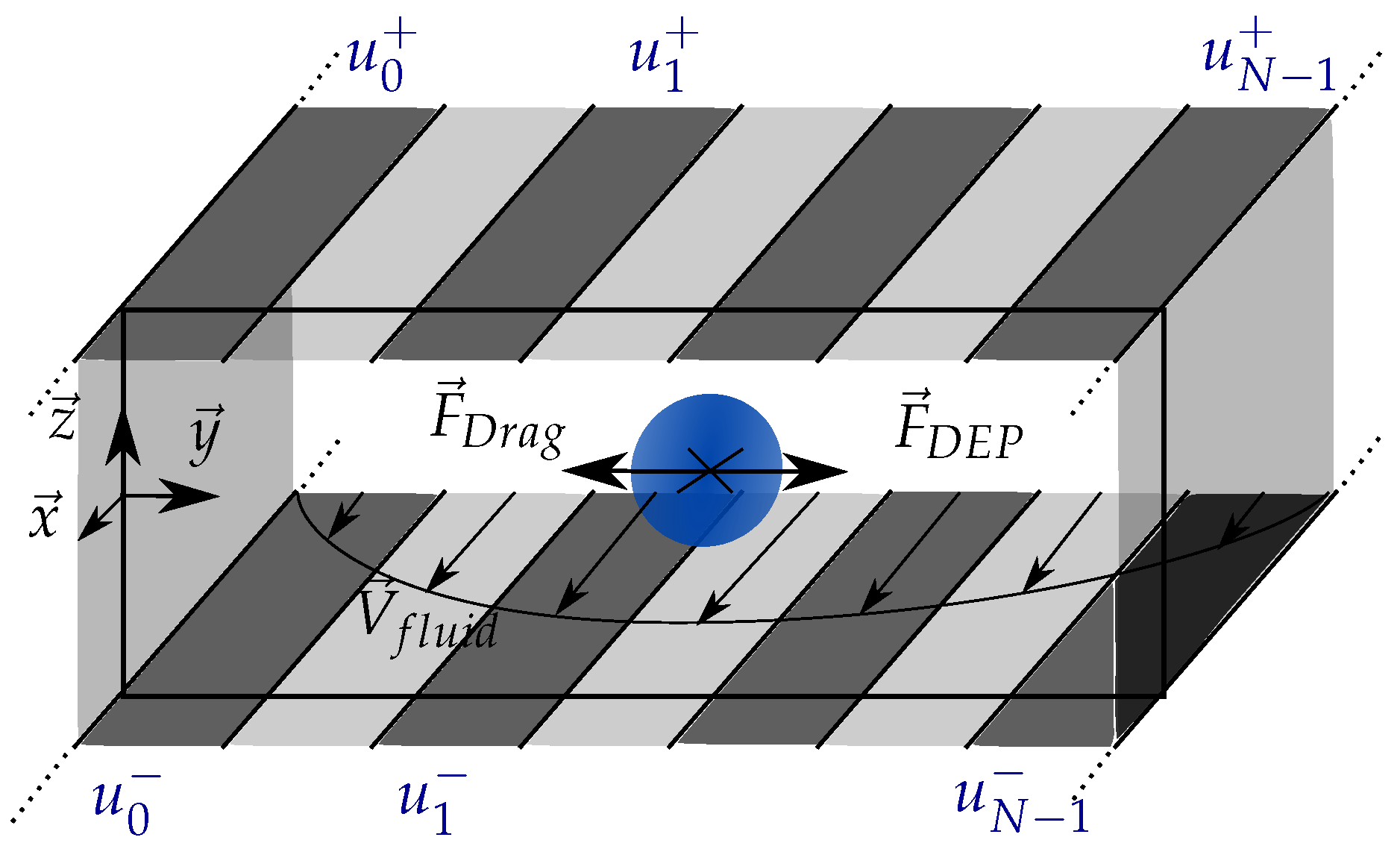
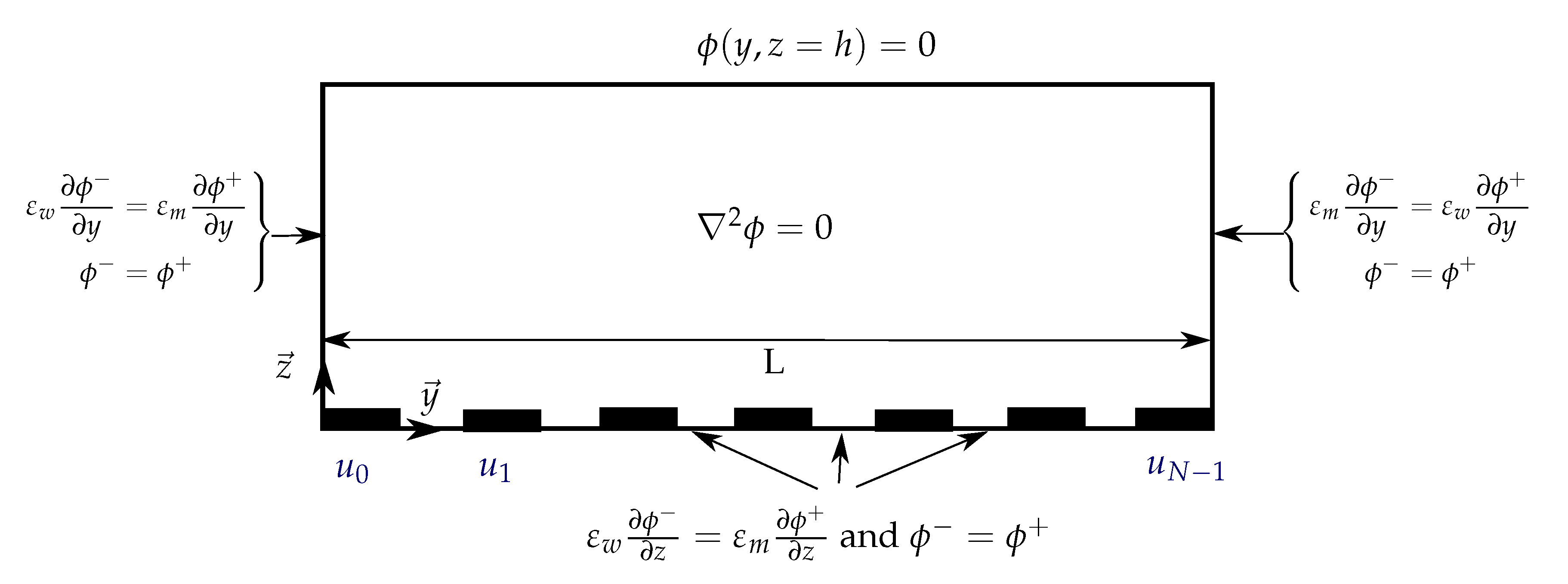


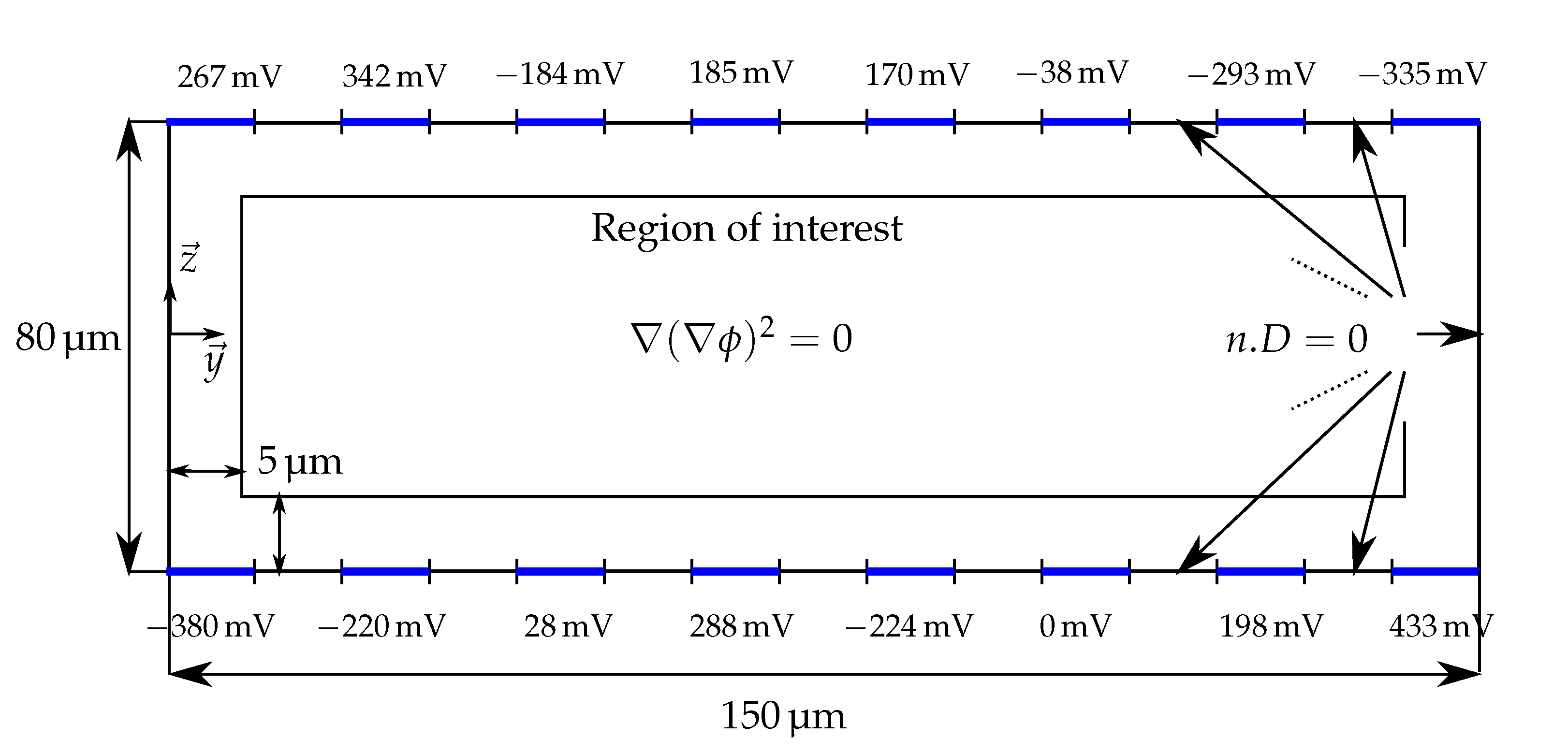
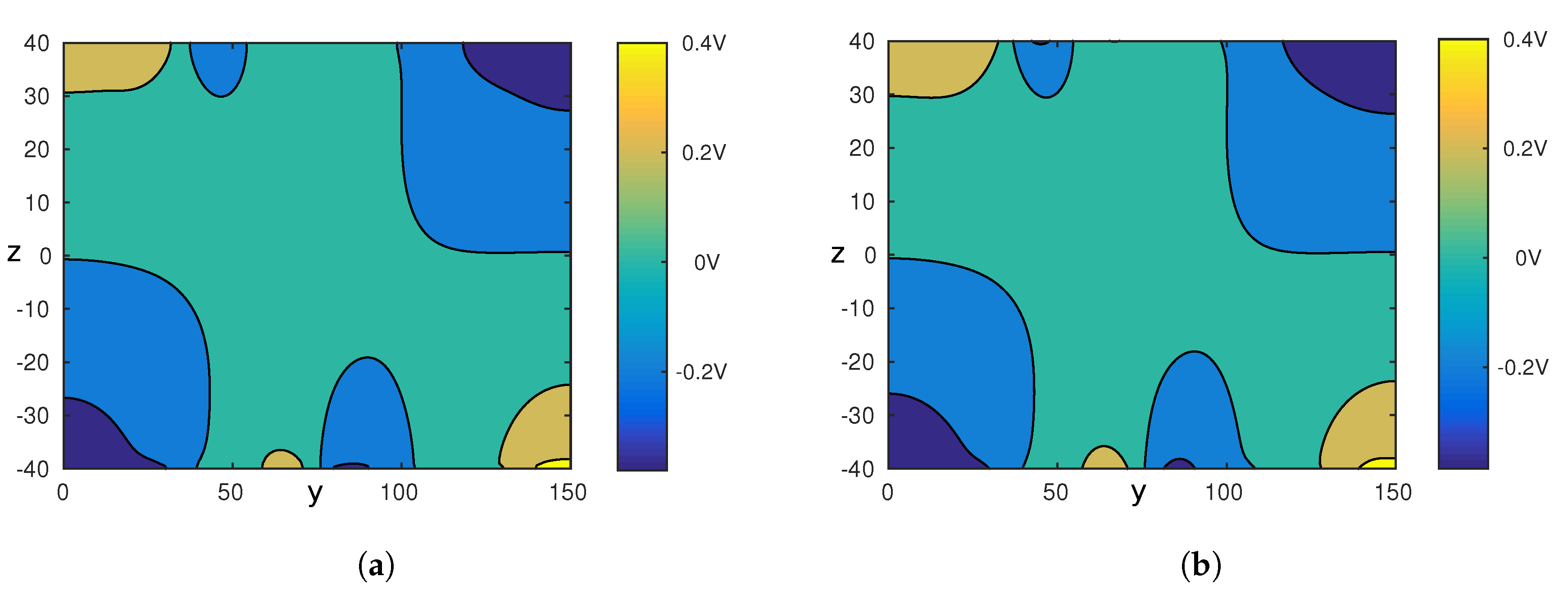
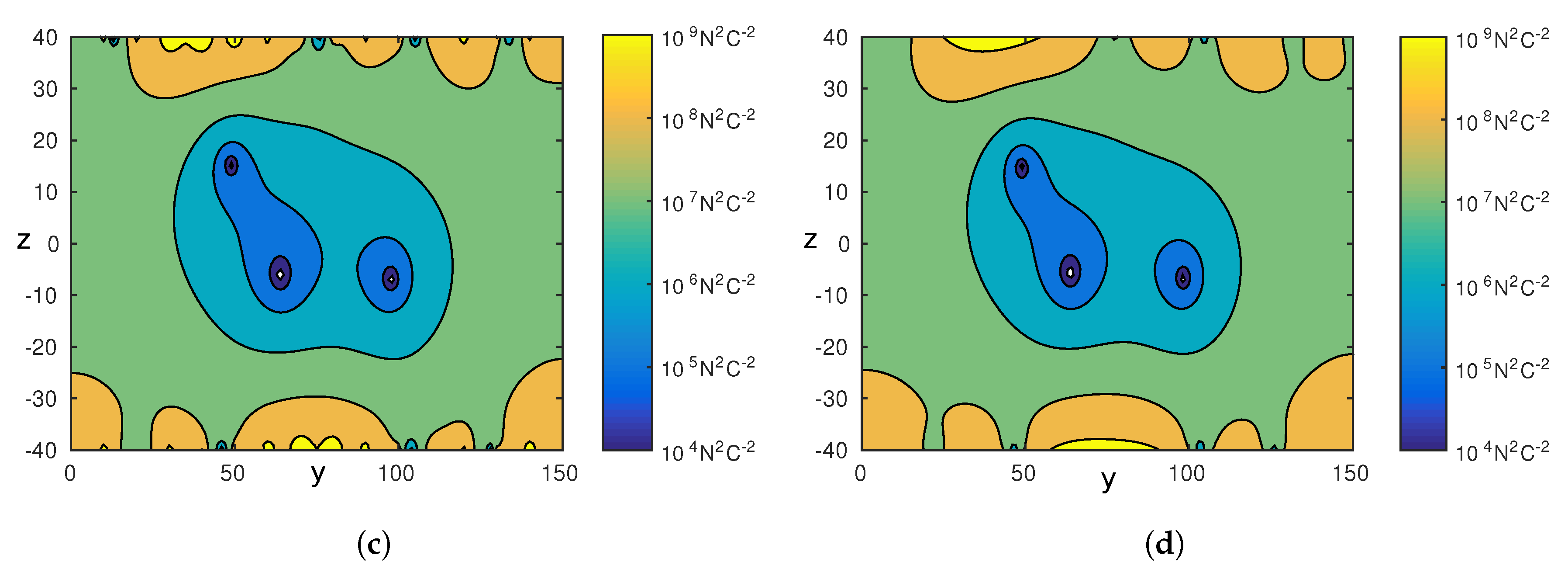
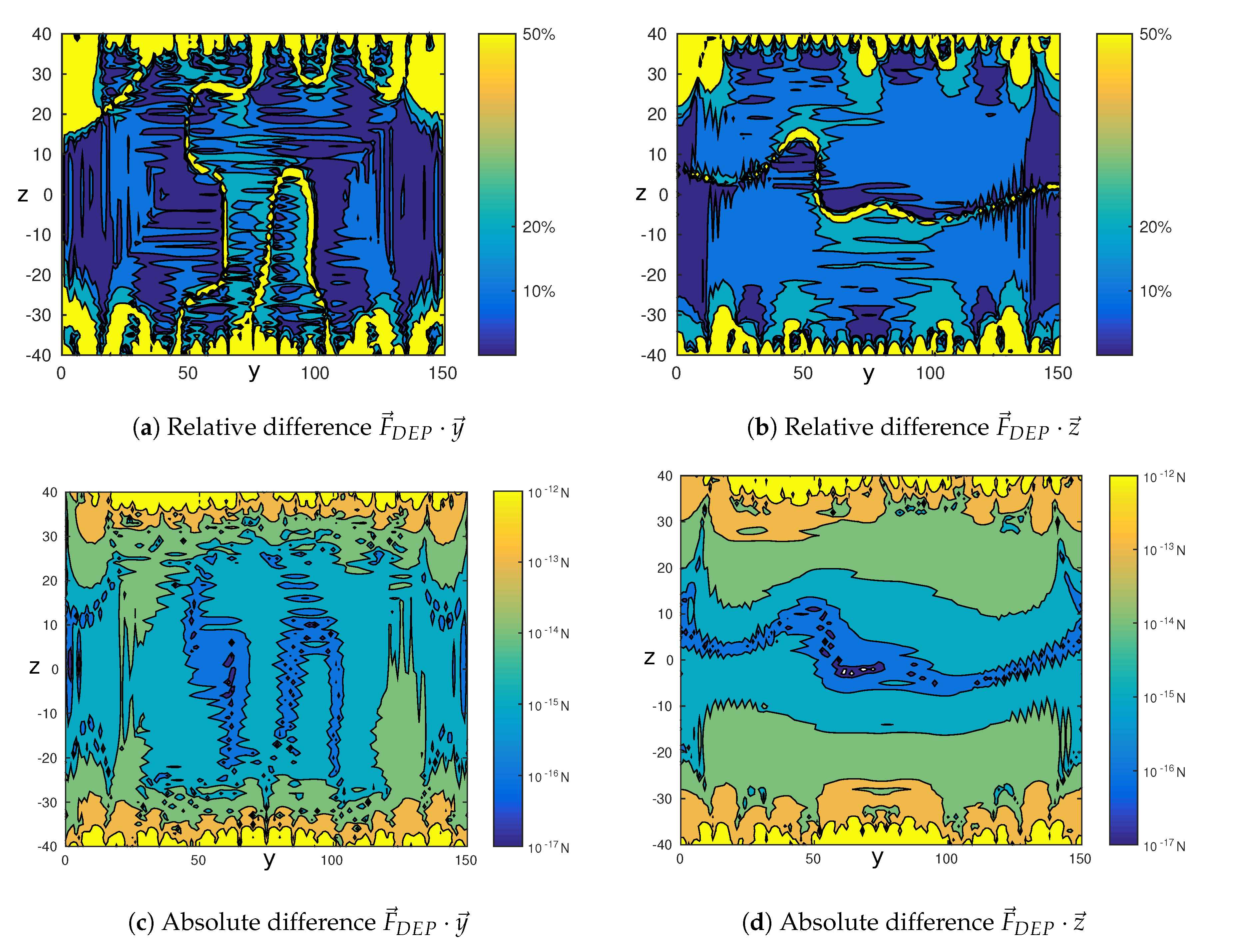
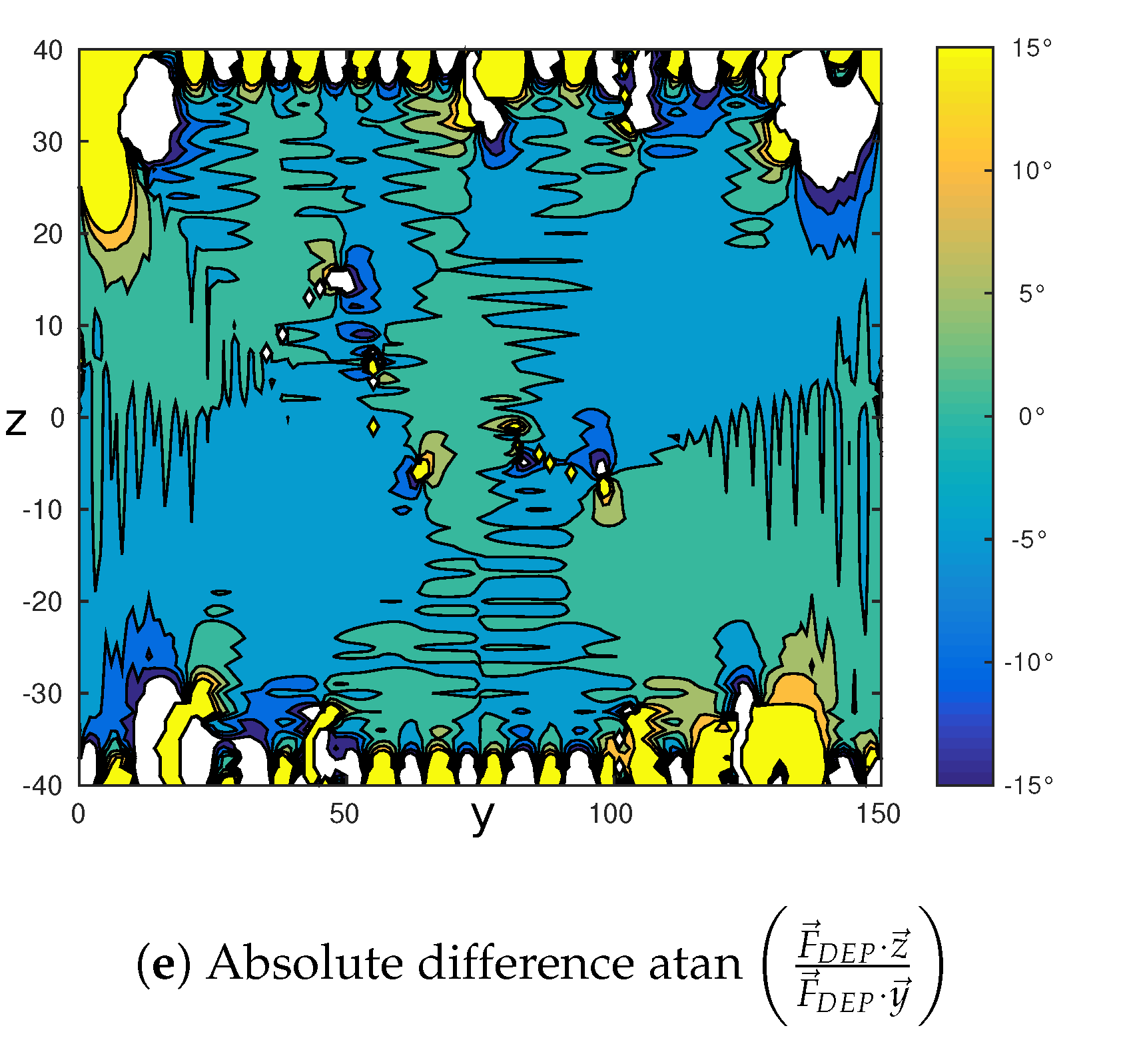
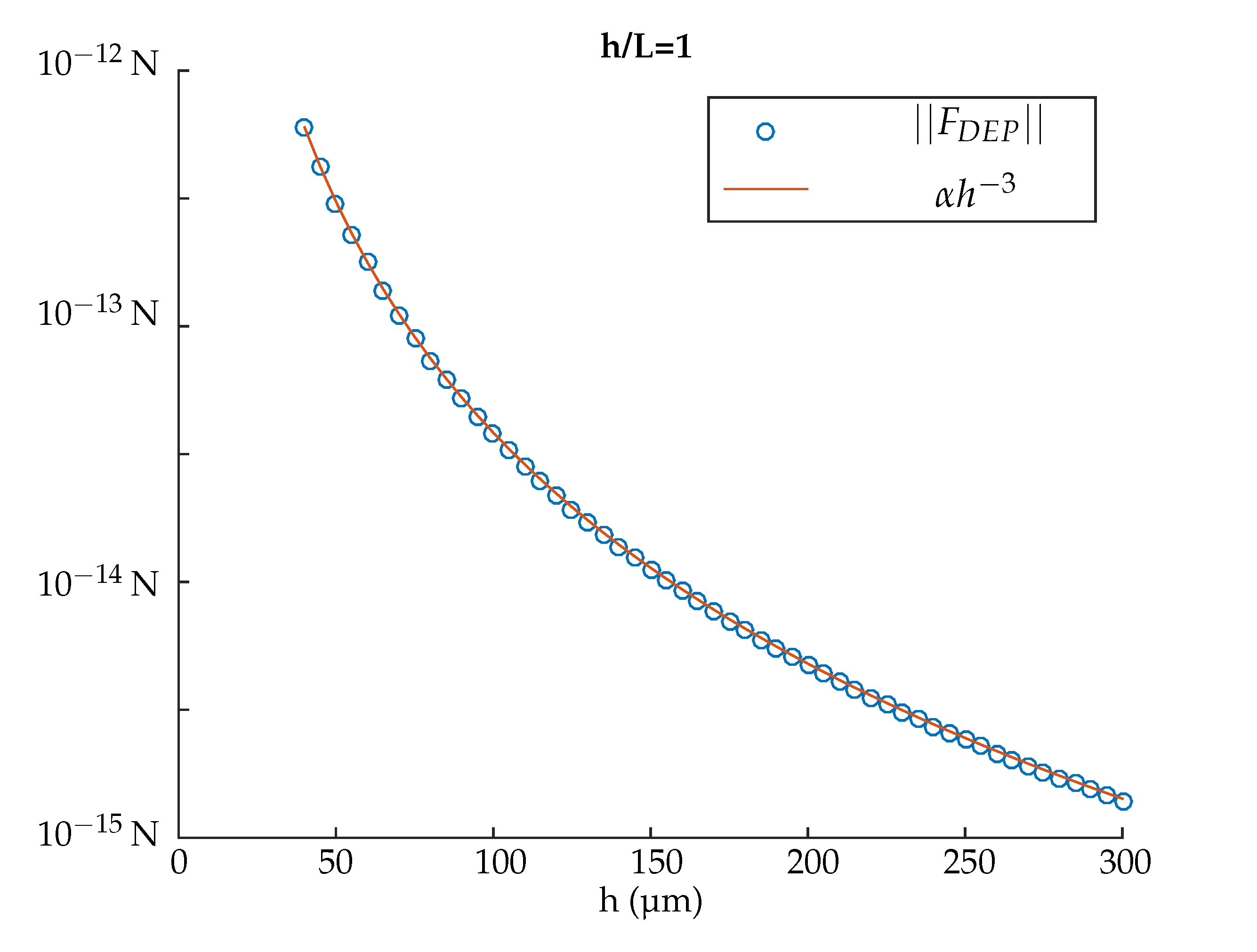
| N = 5 | N = 7 | N = 9 | N = 11 | N = 13 | N = 15 | |
|---|---|---|---|---|---|---|
| 56.9° | 44.8° | 39.3° | 35.0° | 32.4° | 31.1° | |
| 42.2° | 32.6° | 28.7° | 25.2° | 24.0° | 23.9° | |
| 43.0° | 32.3° | 28.6° | 25.4° | 24.1° | 23.8° | |
| 41.5° | 32.1° | 28.2° | 25.4° | 24.2° | 24.1° |
| N = 5 | N = 7 | N = 9 | N = 11 | N = 13 | N = 15 | |
|---|---|---|---|---|---|---|
| t | 0.214 | 0.208 | 0.209 | 0.217 | 0.218 | 0.221 |
© 2017 by the authors. Licensee MDPI, Basel, Switzerland. This article is an open access article distributed under the terms and conditions of the Creative Commons Attribution (CC BY) license (http://creativecommons.org/licenses/by/4.0/).
Share and Cite
Gauthier, V.; Bolopion, A.; Gauthier, M. Analytical Formulation of the Electric Field Induced by Electrode Arrays: Towards Automated Dielectrophoretic Cell Sorting. Micromachines 2017, 8, 253. https://doi.org/10.3390/mi8080253
Gauthier V, Bolopion A, Gauthier M. Analytical Formulation of the Electric Field Induced by Electrode Arrays: Towards Automated Dielectrophoretic Cell Sorting. Micromachines. 2017; 8(8):253. https://doi.org/10.3390/mi8080253
Chicago/Turabian StyleGauthier, Vladimir, Aude Bolopion, and Michaël Gauthier. 2017. "Analytical Formulation of the Electric Field Induced by Electrode Arrays: Towards Automated Dielectrophoretic Cell Sorting" Micromachines 8, no. 8: 253. https://doi.org/10.3390/mi8080253





